Related Research Articles

Kokonoe stable is a stable of sumo wrestlers, one of the Takasago group of stables. It was formed in 1967 and until 2021 was located in Ishiwara, Sumida, Tokyo. As of January 2023 it had 26 sumo wrestlers, four of whom are of sekitori rank. It is the most successful stable in terms of total yūshō won by its wrestlers, with 52.
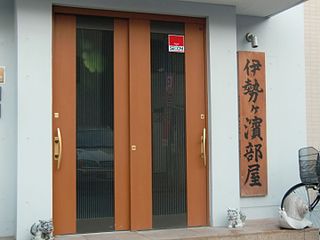
Isegahama stable, formerly known as Ajigawa stable from 1979 to 2007, is a stable of sumo wrestlers, part of the Isegahama ichimon or group of stables. Its current head coach is former yokozuna Asahifuji.

Takamisakari Seiken is a former sumo wrestler from Aomori Prefecture, Japan. A former amateur champion, he turned professional in 1999 and established himself in the top division in 2002 after a brief appearance in 2000. He received five special prizes for his achievements in tournaments and earned two gold stars for defeating yokozuna. The highest rank he reached was komusubi, which he held on two occasions. He was one of the most popular wrestlers in sumo in his time, largely due to his eccentric warm-ups before his matches. He retired in January 2013 to become a coach at Azumazeki stable, having taken the toshiyori-kabu Furiwake-oyakata. In January 2020 he became head coach of Azumazeki stable, following the death of the former Ushiomaru.

Tokitsuumi Masahiro is a former professional sumo wrestler from Fukue, Nagasaki, Japan. A former amateur sumo champion, he turned professional in 1996. His highest rank was maegashira 3. He became the head coach of Tokitsukaze stable in 2007 following the dismissal of the previous stablemaster. He was asked to retire by the Japan Sumo Association in February 2021 for violating COVID-19 safety protocols.
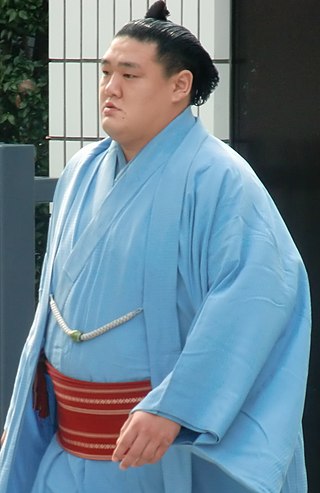
Hōchiyama Kōkan is a former sumo wrestler from Hirosaki, Aomori Prefecture, Japan. He joined professional sumo in 2000. His highest rank was maegashira 14, achieved in 2006. After illness saw him demoted to the third makushita division in 2008, he returned to the second highest jūryō division in 2010 and the top makuuchi division in September 2011. After winning the sandanme division he had just been demoted to in November 2013, he chose to retire. He is now a coach at Sakaigawa stable under the name of Dekiyama (出来山).
Kōbō Kenichi was a Japanese sumo wrestler. His highest rank was maegashira 9.

Minezaki stable was a stable of sumo wrestlers, one of the Nishonoseki ichimon or group of stables. It was founded in December 1988 by Misugiiso, who branched off from the Hanaregoma stable and enrolled his younger brother as a wrestler. As of January 2021 it had seven wrestlers. It was located in the Nerima ward of Tokyo. After the May 2012 tournament it absorbed Hanakago stable, run by former sekiwake Daijuyama, who became an assistant coach. The stable never produced a sekitori wrestler on its own, but inherited Arawashi, previously of Hanakago and before that Araiso stable, who first reached jūryō in July 2011. Minezaki stable already had a Mongolian wrestler, Torugawa, but was allowed to take another foreigner because of the merger. Hanakago stable's Ryūkiyama from South Korea was allowed to transfer for the same reason.

Miyagino stable is a stable of sumo wrestlers, part of the Isegahama ichimon or group of stables. It was founded by the 43rd yokozuna Yoshibayama as Yoshibayama dōjō while he was still an active wrestler, before changing to its current name in 1960. As of January 2023, the stable had 20 wrestlers, with two of them ranked in the second highest professional division.

The Michinoku stable was a stable of sumo wrestlers, part of the Tokitsukaze ichimon or group of stables. It was established in 1974 by former maegashira Hoshikabuto, who branched off from Izutsu stable, and closed in April 2024, at the time of the retirement of former ōzeki Kirishima, who became the stable head coach in December 1997.

Ōshima stable, formerly known as Tomozuna stable, is a stable of sumo wrestlers, part of the Isegahama ichimon or group of stables. As of January 2023, it has seven wrestlers.

Kasugayama stable was a stable of sumo wrestlers, part of the Isegahama ichimon or group of stables. In its modern form it dates from 1954 when it was re-established by former ōzeki Nayoroiwa who led it until his death in 1971. It went out of existence in 1990 when the stablemaster, former maegashira Ōnobori, reached the mandatory retirement age of sixty-five, and was absorbed by Ajigawa stable, but it was revived by Kasugafuji after his retirement as an active wrestler in 1996. As of January 2016 it had 23 wrestlers. Its only wrestler to reach the top division was the Korean born Kasugaō who retired in 2011.

Tomonohana Shinya is a former sumo wrestler from Yatsushiro, Kumamoto Prefecture, Japan. His highest rank was komusubi. He is now a sumo coach.
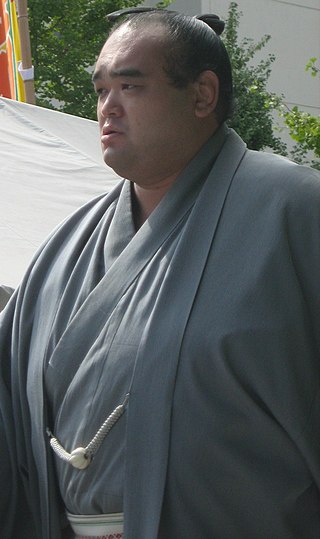
Bushūyama Takashi is a Japanese former sumo wrestler from Aomori, Aomori Prefecture. He made his professional debut in January 1999. At the age of 32, he was promoted to the top makuuchi division in the November 2008 tournament. His highest rank was maegashira 3. He is now a sumo coach.
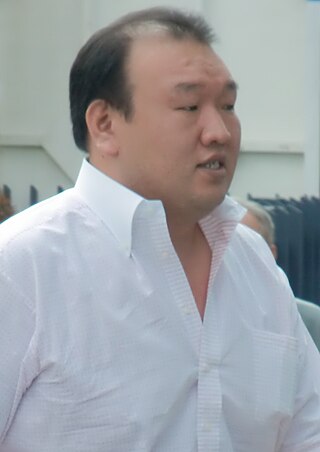
Ganyū Kenji is a former sumo wrestler from Himeji, Hyōgo, Japan. He made his professional debut in March 1986, and reached the top division in March 1996. His highest rank was maegashira 1. He retired in 2000 and became an elder of the Japan Sumo Association. In 2015 he became the head coach of Yamahibiki stable following the death of his old stablemaster, Kitanoumi.
Nakagawa stable was a stable of sumo wrestlers, part of the Tokitsukaze ichimon or group of stables. It was founded on January 26, 2017 with nine wrestlers, all of whom were previously members of Kasugayama stable. That stable closed in October 2016, with its wrestlers living temporarily in Oitekaze stable. One of Oitekaze's coaches, Nakagawa-oyakata, agreed to become the head coach of the newly formed stable. He effectively replaced Kasugayama-oyakata, who was forced to resign from the Japan Sumo Association on January 16, 2017, because of a legal dispute with the previous Kasugayama-oyakata which meant he was unable to obtain the necessary toshiyori-kabu certificate to remain a stablemaster. As of January 2020 the stable had nine wrestlers.

Daishōhō Kiyohiro is a Mongolian professional sumo wrestler from Ulaanbaatar. He began his professional sumo career in 2013 at the age of eighteen. His highest rank to date has been maegashira 9. He wrestles for the Oitekaze stable.
The following are the events in professional sumo during 2022.
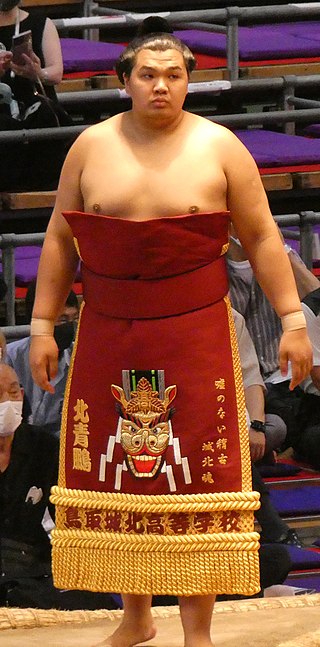
Hokuseihō Osamu (北青鵬 治, born 12 November 2001 as Ariunaagiin Davaaninj is a Mongolian-born Japanese former sumo wrestler from the Miyagino stable. He was recruited by the former yokozuna Hakuhō, and had been regarded as his protégé. He made his professional debut in March 2020 and won his first 21 matches. His highest achieved rank was maegashira 6.

Tamashōhō Manpei, born March 6, 1993, as Erdenebileg Enkhmanlai is a Mongolian professional sumo wrestler from Ulaanbaatar, Mongolia. Wrestling for Kataonami stable, his highest rank is jūryō 1.
The following are the events in professional sumo during 2024.
References
- ↑ "Oyakata (Coaches)". Nihon Sumo Kyokai. Retrieved 17 August 2016.
- 1 2 3 "Sumo violence: Stablemaster demoted for abusing disciples". Asahi Shimbun. 14 July 2020. Retrieved 14 July 2020.
- ↑ "降格処分の中川親方 3人の弟子に「ぼんくら」「殺すぞ」暴言と暴力繰り返す". Tokyo Sports (in Japanese). 13 July 2020. Retrieved 13 July 2020.
- ↑ "暴力、暴言の中川親方、2階級降格 部屋は閉鎖、時津風部屋の部屋付き親方に". daily.co.jp. 13 July 2020. Retrieved 13 July 2020.
- ↑ "Asahisato Kenji Rikishi Information". Sumo Reference. Retrieved 2 September 2012.